Old furniture lost former gloss? Tired, but threw it sorry? All this is fixable: it is possible to improve the appearance so that no one will think that the furniture is many years. Restoration of furniture with their own hands - painstaking work. But nothing is supervised to do. Some ways are so simple that everyone can cope (speech, of course not about antiques).
Restoration of wooden surfaces
No matter how neatly handled furniture, scratching, scratches, stains arise. They are easy to eliminate. The main thing is to know how and what.
- If the wooden surface simply lost the gloss, find a means of caring for wood consisting of which is orange oil. Take a clean sponge, slightly moisten it and 20-30 seconds melting in the microwave. Sprinkling a means of a spray, trace with a hot sponge (hands should be in rubber gloves with a spraying inside).
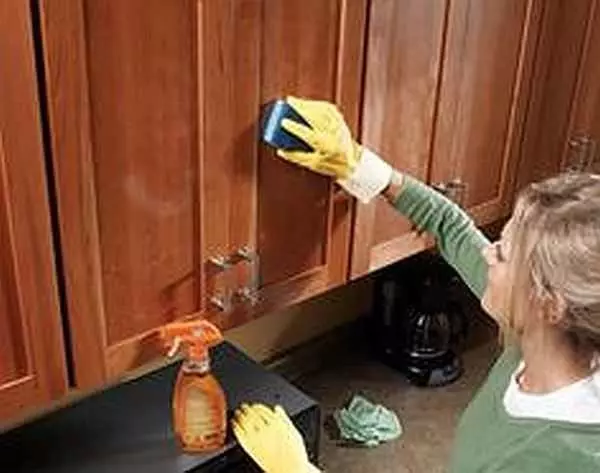
Hot sponge and oil with orange butter will be returned with wooden furniture gloss
- If there is a scuffing, stains on the tree, you can try to cope with them listened by a banana skirt. With minor damage helps well.
- More serious stains require serious measures. These are retouching markers (there are in stores selling furniture fittings), denatured alcohol and wax. First we clean the surface (detergent for dishes, diluted in water - the best output). Dried after cleansing wood wipe with alcohol: a swirling swivel with a well-tempered place. In most cases, the color is restored. In deep scratches, alcohol does not restore the color, they are painted with a marker of suitable color. To impart brilliance, the surface is covered on top with wax and polished with a soft cloth.
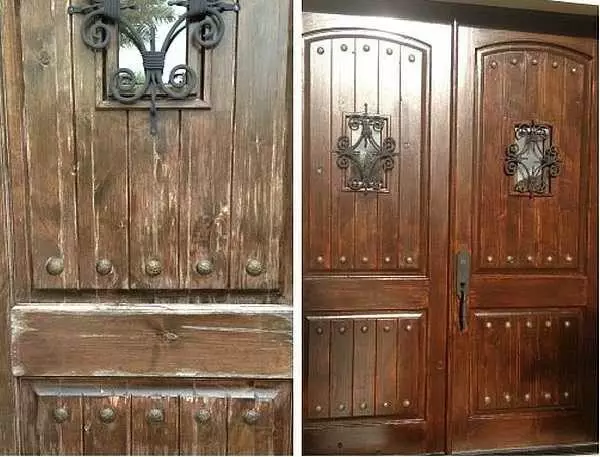
Such transformations are possible using marker, alcohol and wax
- If you need to compare small irregularities, you can use the nail file. It is easier to clean it easier for scrupulous work than emery paper.
- If the wood is locally bluffing from moisture: put a leaking vessel, quickly get rid of the defect and neutralize its consequences can be mixed with salt and olive oil. Kashitsa is applied to damage and rub in circular motions. Leave for 20-30 minutes. Salt will pull out water, and the olive oil will return the fibers elasticity.
- If there are chips, do not do without putty. Suitable as a special for wood, and automotive. The best way is to buy a light and add a kel into it as needed. Skol is embarrassed, a little putty is smeared by the adjacent surface. After drying, everything is well aligned with a small grain sandpaper.
Perhaps you will be interested to read what the shelves are on the wall (with drawings).
We restore polishing
The restoration of the lacquer layer is complex. Any furniture restoration begins with cleansing and degreasing and repairing the lacquer coating too. We use the detergent for dishes, diluted in water: safe and securely. After drying, proceed to updating polishing.
- On Dark Furniture, the scratch can be painted with iodine, seeking the desired color by the number of layers or exploding it with water. If there are furniture markers, you can use them.
- Deep scratches that beat, so do not scream. There are other methods:
- Make mastic from 4 parts of melted wax and 3 parts of the turpidar. This paste is applied to polish and soft cloth rubbed.
- If there is a cream for shoes suitable color, you can smear them, and then polish everything with a cloth.
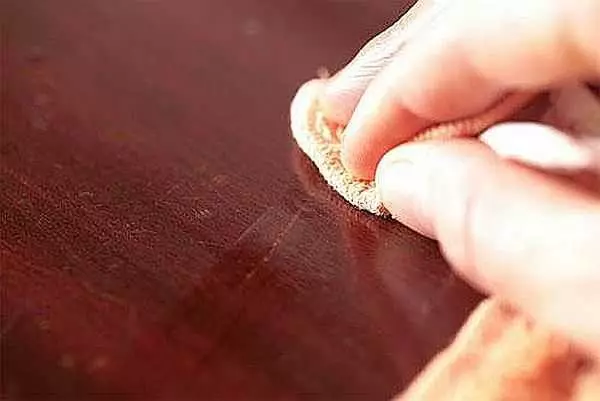
Scratches are painted, then the coating is restored
- The stains of unknown or known origin are removed with pure gasoline. The soft cloth is wetted and rubbed. For particularly difficult cases, repeated processing may need, but sooner or later, any spots are output. Then the soft cloth everything polishes to the brilliance. A mixture of linseed oil with denatured alcohol will help to restore it.
- If the stains remained from hot - white circles from cups or other items, they are wiped with alcohol. You can also repeat several times. After the stain disappeared, the surface is updated with a mixture of linseed oil and denatured alcohol.
- Particularly deep stains from hot, it is easier to remove oil and alcohol with a mixture. This composition flashes a stain to complete disappearance. Then wipe the alcohol and polish the rag.
It is easy to refresh the faded polishing on the furniture can be cooked with their own hands with mixtures:
- Two parts of linseed oil and turpentor and part of vinegar. Everyone is mixed, apply a tampon, waiting until it is absorbed and polished.
- Mix in equal parts oil and beer and make the furniture to rub furniture. Once he has absorbed.
- A more shiny surface will be, if the beer boils with a piece of wax, cool and slightly warm to furniture. When the composition is absorbed, the surface is rubbed to shine.
A few more recipes in the video.
How to remove polishing from furniture
It is often enough to polish remove: not the most fashionable is a finish. Modern furniture is most often painted with shelled or tinting paints, and the surface is matte. In any case, you need to remove polishing. Methods are several. Since varnishes are different in composition, it is necessary to select an experimental way. But one of the methods should work.
- Remove the old polishing from furniture can be mechanically. If there is a grinder - the process will go faster, if not, take sandpaper with large grain and read the lacquer layer until wood appears. Then take a shallow grain and grind to a flat surface. Mechanical removal is not always triggered. Sometimes even the grinding does not give results: polished is not considered, but it starts to melt and stink. Then the tactics change.
- It will take a piece of old glass. You put on gloves and break it into several fragments. Sharp edges that were formed, clean the wood coating. If there are chamfer and deepening, it is convenient to scatter sharp edges in them. After the main layer of polishing is removed, the sandpaper with small grain is all adjusted to a smooth state.
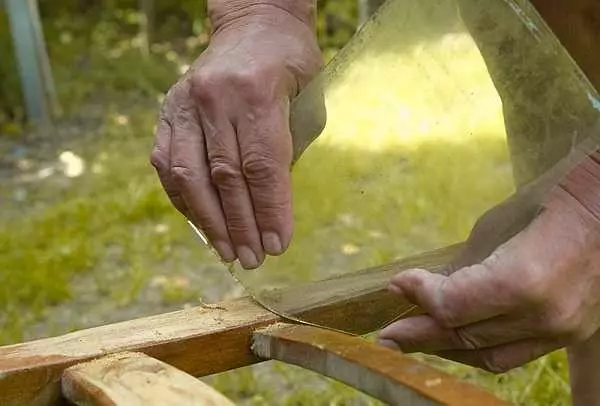
Often the restoration of furniture with your own hands requires gesting measures: some types of polishing can only scraple with glass
- If work with glass does not impark you, chemical methods remain. There are ready-made polishing agents. You can work with them or outdoors or on draft: evaporation is harmful. How to remove polishing - you need to read on the package. Funds are different and duration and processing procedure may vary.
How to paint polished furniture
If the old furniture was preparing under painting, it should be cleaned of dust, wipe with a damp cloth and give dry. After aligning everything with putty, to charm all the irregularities, wait until he dries. Take the sandpaper and hang over the middle again, then small grain. Next, we apply a layer of primer and wait for it drying.
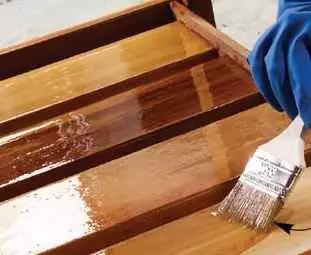
Applying a varnish with a brush when restoring polishing furniture
The primer is bought under that paint that is going to use, or you can breed a paint with a compatible solvent and covered instead of soil. After drying, you can paint.
You can paint with roller or brush. Usually you need several layers: do not try to immediately apply a lot of paint, as the drums may appear. It is better to apply a few thin layers. So the surface will be smooth and monophonic. Another trick: for uniform painting, the layers are applied in different directions - along, then across. This also applies to varnish.
With some kinds of varnish it is easier to work when they are warm. They are slightly heated and then they are applied to a spray or brush. When heated, you need to be careful: pairs can flash.
In order of staining: first paint the inner surfaces, edges and joints, then go to the outer. With such a sequence, there is less chances to be blocked or covered with a painted surface, spoiling it.
If the lacquer coating is smooth, without defects, and it must be painted, you can do without removing this layer. There are special soils for complex surfaces. Wash the surface with them, and after drying, colors. They have components that penetrate even in a layer of varnish. Therefore, the paint will be well applied and long to stay. But such soils have a minus: they are expensive. But significantly save time.
Some secrets of wood coloring (including brash and coloring in two colors) are in the article "How to paint the lining". Several secrets of smooth application of acrylic paint look in the video.
If the recovery did not bring the expected result, you can change the appearance? How to redo the furniture on a new way is described here.
How to restore veneer
Veneered furniture requires a special approach. The means are mostly the same, the methods are different. For example, if after hitting the veneer, it was swollen, in a disposable syringe, pick up PVA glue, pierce the bubble, enter the glue into the cavity. Top plays a piece of tight fabric and put the load. If the surface is uneven (convex or concave), a bag of dense tissue with heated sand is used as a cargo.
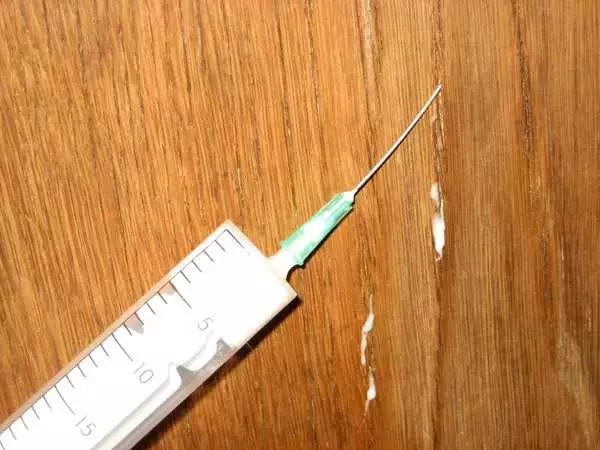
Such a veneer damage is restored in two stages. First, bloating is eliminated, after scratching is painted and the coating is restored.
If the veneer is glued to alcohol adhesive, it is possible to return a swollen part into place. You can swallowing through a rag with a hot iron. But you should not overheat the iron: the veneer can stretch. The degree of heating is average.
If ironing through a dry rag does not help, try to repeat the operation with a wet (wet and squeeze it well). There is a chance that the wood will swell and become more elastic. For reliable fixation of the bloody, you can enter the PVA, and then heat it with an iron.
If the swelling cracked, it can also be tried to flick with warming (through a rag). If it did not work, tear off the detached piece. Do not cut off, namely, we are lazy: on the spanding of faults after the restoration is less noticeable than cuts. Therefore, lagging behind the lagging piece. From the place of damage and a piece of veneer, the old glue (emery paper or nail files - depending on sizes). Next, the repair of the veneer on the furniture is standard: smeared PVA glue, laid, laying the lines of faults, topped with thick tissue and put the cargo before drying.
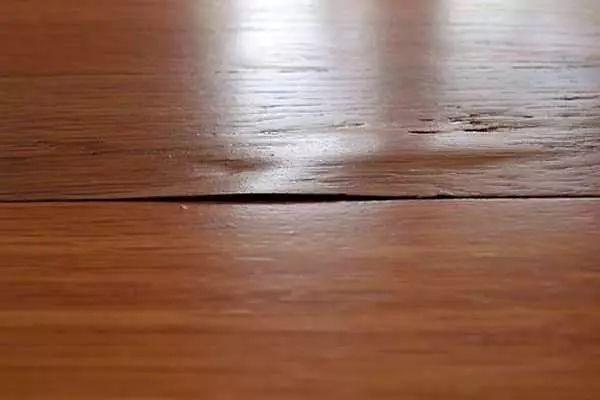
Such a penetration of a veneer is most likely possible to eliminate simply in the iron
Scratches and traces of restoration on the veneer are also removed as on the tree: painted with a furniture marker of a suitable shade. If the scratch is deep, some molten wax are applied to it for furniture restoration (spatula). After drying, the wax is rubbed, if necessary, elaborate paper with thin grain is used, but after such a processing, a renovated piece is covered with a layer of varnish.
Restoration of furniture with your own hands requires patience and accuracy. It is necessary to act gradually and methodically: smeared, waiting for drying, fired, again smeared, etc. Sometimes you have to try multiple methods: damage is different, as well as materials that are used in the manufacture (glue, varnishes, etc.). But as a result, the furniture will look much better.
Article on the topic: how to get rid of the smell of urine on the sofa of an adult
